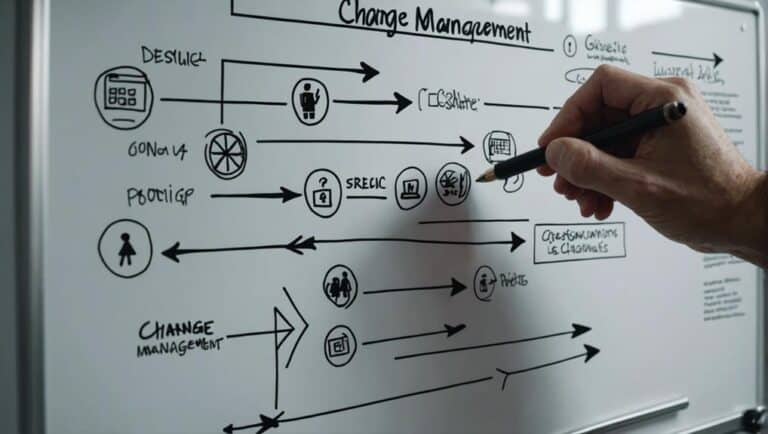Change can be a daunting concept, but it can also be an incredibly powerful tool. With the right strategies and approach, change can actually be an incredibly positive force in your organization.
In this blog post, we’ll be taking a look at the benefits and challenges of implementing change management strategies in your business.
Understanding Change Management
Change management is about understanding how to manage and implement changes in an organization in order to minimise disruption and ensure any change is successful.
It involves a structured approach to defining and incorporating changes into an organization’s operations.
Change management includes activities such as developing plans, reaching consensus on objectives, identifying stakeholders, assessing risks, and developing implementation strategies.
It is a key component of any successful business initiative, as it provides an understanding of the changes needed and a framework for managing those changes.
By following these steps and principles, organizations can maximize the advantages of change while minimizing its potential risks and costs.
The key benefits are:
- Increased Agility and Adaptability
- Improved Organizational Performance
- Enhanced Employee Satisfaction
- Reduced Risk of Failed Projects
- Better Communication and Collaboration
- Increased Employee Alignment and Engagement
- Improved Process Efficiency
- Increased Productivity & Profitability
Accessing these benefits involves developing a plan for handling transitions, communicating the intended changes, and training employees on those changes.
Change management is a critical tool for any organization undergoing a big shift, such as introducing a new product or implementing a new process.
An effective change management strategy focuses on minimizing disruption, engaging stakeholders, and creating an environment of acceptance for the new direction.
Three key concepts of change management:
- It can help foster a culture of innovation and creativity in an organization.
- By managing change effectively, organizations can better adapt to the ever-changing business environment.
- It enables organizations to identify potential risks and develop strategies to mitigate them, thus increasing overall efficiency and productivity.

Benefits of Change Management Strategies
Change management strategies can help organizations to identify potential risks and create pathways for successful transitions.
It is an essential tool for guiding organizations through a period of change, whether it is the introduction of new technologies, restructuring the organization due to changes in the competitive landscape or through a period of rapid growth.
Implementing change management allows organizations to create a plan for managing and mitigating the risks associated with any change initiative.
By evaluating the current processes, organizations can better understand how to effectively manage any change that needs to be implemented.
Additionally, it can ensure that teams are able to work together collaboratively and effectively during the transition period.
These strategies can result in successful transitions for organizations and help them achieve their goals.
Developing a clear communication plan can ensure that all stakeholders are aware of how the changes will affect them.
Change management is an essential part of the process to ensure that the change is successful and all stakeholders understand the implications of the change.
Effective change management requires a plan to be devised in order to identify stakeholders, assess the impact of the change and develop a communication strategy to inform stakeholders about the proposed changes.
This should consider how stakeholders will be informed, what type of information needs to be communicated and how this will be distributed.
Ultimately, managing change effectively helps ensure that employees, customers and other stakeholders are engaged with the process, helping to drive successful outcomes.
Strategic planning and analysis can help ensure that organizations are prepared for any unexpected events that may arise during times of change.
All in all, it is clear that effective change management starts with strategic planning and analysis.
By anticipating potential changes and developing plans ahead of time, organizations can ensure they are ready to manage any unexpected events that may arise during times of transition.
Change management is an essential tool for any organization striving for success.

Challenges of Implementing Change Management Strategies
Implementing change management strategies can be challenging due to resistance from employees.
It is important to recognize the potential pushback and devise a plan to manage the change effectively.
This may involve communicating the need for change, developing a clear strategy and timeline, ensuring the team is well-equipped to handle the transition, and providing adequate support throughout the process.
Additionally, actively engaging stakeholders in conveying the vision of how subsequent change will benefit them can go a long way in encouraging a smoother transition.
Overall, making sure to create an open dialogue and consider all perspectives is essential for successful management of change.
It can also be difficult to gain buy-in from key stakeholders and ensure that the changes are properly communicated when managing change within an organisation.
Effective change management requires a clear plan of action, with strategies to identify and assess potential risks, provide training and education for staff, and develop appropriate communication plans.
It is important to ensure that any changes are carefully implemented in order to ensure successful outcomes.
Change management must be managed in an efficient and transparent manner, while also considering the needs of the organisation.
By taking into account different perspectives from within the organisation, it is possible to create successful change management initiatives that benefit both employees and the organisation as a whole.
Change management requires clear objectives that are aligned with the organization’s overall goals, as well as effective monitoring of progress and results.
Thereafter, it is of paramount importance that clear objectives are identified in the change management process and effectively monitored, to ensure that they are in line with the organization’s goals.
This will help to ensure that progress and results are achievable, resulting in maximum efficiency and success for the organization.

Steps to Overcome Change Management Challenges
Identify the key stakeholders, understand their needs and build relationships is the bedrock of successful change management.
By determining who is impacted by the change, it is possible to comprehend how best to manage the transformation.
With this information, it is possible to create specific processes which can be tailored to each stakeholder, optimising their success in navigating and engaging with the changes.
Additionally, by building effective relationships, it allows for clear communication of the changes and ensures expectations are managed in order to successfully bring about change.
Communicate the change consistently, ensuring everyone is aware of the objectives and how they will be affected. Popular methods of communication include:
- Conduct team meetings to discuss the changes
- Give employees a timeline of when the changes will take place
- Provide employees with detailed documentation on the changes
- Create an employee survey to assess the impact of the changes
- Provide training and support for employees on the changes
- Involve employees in the decision-making process
- Monitor and evaluate the impact of the changes
- Schedule regular check-ins to review how the changes are going and how employees are adapting to them.
Change management is a critical process when it comes to organizational development and involves the implementation of strategies, plans, and practices in order to successfully manage change.
It is important for organizations to undertake a systematic approach when managing change for it to be successful.
By taking a holistic view of the organization, change management strategies can be identified and implemented which will enable proper assessment and utilization of the resources available.
People should be kept in the loop when changes are happening so that they understand how their roles might be affected by the change.
Utilizing different communications channels such as emails, presentations, or team meetings will help ensure information is accurately conveyed and understood.
Regular assessments are essential to ensure any resistance to change is addressed in order to keep the objectives on track.
Provide training to ensure employees are well-equipped to deal with any new tasks or processes that come with the change.
Moreover, managing change requires a commitment to cultivating an environment where change is embraced and supported.
Training is an essential part of this, as it ensures that employees are equipped with the skills and knowledge they need to adapt to new tasks or processes.
Through effective training, employees can be equipped to successfully manage the changes that come their way and build confidence in their ability to do so.
Best Practices for Effective Changes
Clear communication is essential for successful change management.
All stakeholders should be kept informed of the changes to ensure everyone is on the same page.
Proper communication should include the objectives of the change, responsibilities assigned to each team, a timeline for implementation and any risks associated with the change.
It is important for the project manager to continually assess progress and provide timely updates to all stakeholders.
Change management should also involve processes for assessing feedback from stakeholders, making necessary adjustments and incorporating them into the change process.
In order to ensure a successful transition, regular revisiting of the change plan is key.
This will help ensure that all stakeholders are kept up-to-date and that any changes made are communicated quickly and efficiently.
A well-thought-out plan should also be in place before any changes are implemented.
- Set clear goals and objectives
- Design an implementation plan
- Create a communication and training program
- Monitor progress and evaluate success
- Assess risks and develop contingency plans
- Develop a feedback system to measure accepted change
- Foster an environment of continual learning and support
This will help ensure the changes are properly implemented and that all potential risks are accounted for.
To ensure successful change management, it is important to have a governance framework in place that outlines the steps needed to plan, execute and monitor changes.
This should include communication protocols, assessment criteria, and evaluation processes.
Additionally, teams should be empowered to identify areas for change within their respective departments as well as collaborate with each other to come up with the best solutions for all stakeholders involved.
Ultimately, effective change management will help organizations stay competitive in their markets while minimizing risks that can come with rapid growth or unexpected challenges.
Finally, it’s important to evaluate the success of the changes and make any necessary adjustments to ensure they are beneficial in the long run.
Thus, for successful management of change, it is essential to consistently evaluate and assess the changes implemented.
This can be done by monitoring and measuring the success of these changes, analysing the feedback from stakeholders, and making adjustments as necessary to ensure that the changes are beneficial in the long-term.
What Are Some Challenges That Organizations May Face When Implementing Change Management Strategies?
When improving change management techniques, organizations may face resistance from employees who are comfortable with the status quo. Communication breakdowns, lack of leadership support, and inadequate resources can also create challenges. Additionally, unclear goals and lack of employee involvement can hinder successful implementation of change management strategies.
Monitoring and Evaluating the Impact of Change
To effectively monitor the impact of change, managers should develop systems to measure progress towards the desired outcomes, for example:
- Gather feedback from team members
- Track the progress of change initiatives
- Conduct surveys to assess the success of change management
- Monitor staff morale
- Analyze data from your HR system to measure effectiveness
- Analyze customer feedback to assess customer experience
- Review organizational performance metrics to assess the ROI of change initiatives
- Monitor employee engagement levels to measure impact
It is important for managers to have a clear understanding of the desired end goals, as well as knowledge of the tools and techniques necessary for change management.
Additionally, it is important to have established processes for tracking the success of any changes that are implemented.
Utilizing a structured system of measurement can help ensure that change initiatives are aligned with the organization’s overall mission and vision.
Results must be monitored and reported in order to fully understand the effects of change within the organization and make sure they are heading in the right direction.
They should also look for feedback from employees on their experience of the changes and address any concerns raised.
By actively engaging employees in the management of change, organizations can ensure that the process is successful and that employees feel supported.
Additionally, ensuring that employees understand the reasons behind the changes and how it will impact their roles and work can help to reduce any apprehension or resistance to change.
Establishing an employee feedback loop is also an important part of successful management of change, as it can identify any issues quickly and provide an opportunity for organizational leaders to address those concerns.
Finally, they should review the change process regularly to ensure that it is working as intended and making a positive difference.

Conclusion
All in all, change management is an important process to manage and implement transitions.
It is important to identify key areas of the change process and ensure that all changes are properly planned, communicated and implemented.
Additionally, it is essential to review the change process regularly and assess if it is working as expected and making a positive difference.
With effective change management strategies in place, organizations can ensure successful implementation of transitions with minimum disruption.
In conclusion, change is complex and can be difficult to manage. However, the right strategies and tools can make change management easier and more successful.
The benefits of implementing effective change management strategies far outweigh the potential challenges that you might face.
With careful planning and a comprehensive strategy in place, you can manage change more effectively and reap the benefits of a more dynamic, responsive organization.





